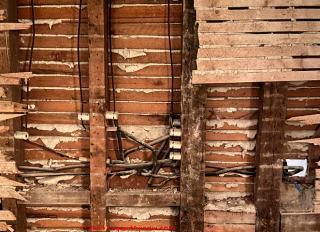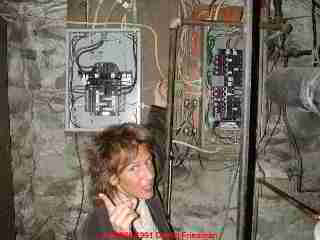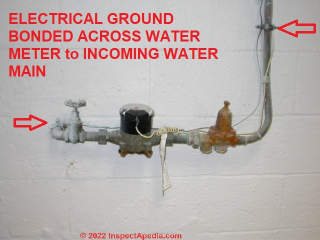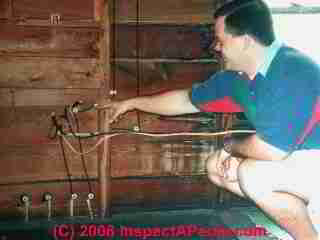 Old House Electrical Ground Safety
Old House Electrical Ground Safety
Electrical Grounding Concerns at Older Buildings
- POST a QUESTION or COMMENT about the electrical ground system in older buildings: inspection, diagnosis, & repair
Old house electrical ground wiring:
This article answers nearly all questions about residential ground wiring & electrical grounding safety in older homes. This article explains the more broad topic of electrical grounding.
Page top photo: our client is pointing to knob and tube wiring in an older home.
InspectAPedia tolerates no conflicts of interest. We have no relationship with advertisers, products, or services discussed at this website.
Electrical Grounding & Other Electrical Safety Concerns in Older Homes
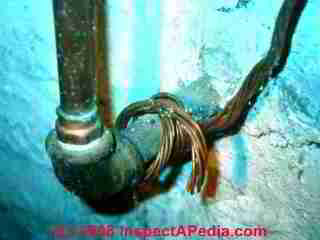 Older homes often have electrical receptacles and fixtures that are ungrounded, and many local codes do not require that they be rewired so they're grounded. That is, existing electrical wiring may be "grandfathered" as "approved" provided it has not been extended or modified.
Older homes often have electrical receptacles and fixtures that are ungrounded, and many local codes do not require that they be rewired so they're grounded. That is, existing electrical wiring may be "grandfathered" as "approved" provided it has not been extended or modified.
Still, grounding is worth adding to your system because it adds protection against electrical shock.
Grounding provides a third path for electricity to travel along, so if there is a leak of any sort, it will flow into the earth rather than into the body of a person who touches a defective fixture, appliance, or tool.
[Click to enlarge any image]
An electrical system is grounded with a grounding rod driven at least 8 feet into the ground outside the house or by connecting to a cold water pipe.
Each individual branch circuit must be grounded as well, either with a separate wire that leads to the neutral bar of the service panel or with metal sheathing that runs without a break from each outlet to the panel. (In theory, electrical outlets can be grounded individually, but this is impractical.)
Absence of good electrical grounding at older homes
Do Older Homes Have Proper & Safe Electrical Ground Wiring?
Often an older building has poor or no working local electrical ground, relying instead on the incoming neutral wire from the electrical service.
Or the building's main electrical ground may have relied on connection to a metal water pipe connected to a well; we've found building ground wires connected to a metal water pipe which used to run out of the building and into earth (possibly a pretty effective ground) but where the metal piping exiting the building had been replaced with a newer plastic water line between the well and the building. In other words, the local ground was completely ineffective.
Modern electrical grounding at residential properties requires use of one or more grounding electrodes connected by an un-spliced wire between the electrode and the ground and neutral bus in the main electrical panel.
Bare aluminum electrical ground wires are sometimes found to have corroded entirely through where the wire touched a damp foundation wall. We also find that the ground wire between the electrical panel and a building water pipe or grounding electrode has become separated, loose, spliced, or lost entirely, as shown in our photo above.
Ungrounded, and False-Grounded electrical circuits in older homes
Two Slot Electrical Receptacles with No Ground
If your outlets have two slots that are the same size, then they are neither polarized nor grounded. These are non-polarized or un-polarized, un-grounded electrical receptacles. This leaves you with no protection against shocks from defective fixtures or appliances using that outlet.
At the very least, you need to install polarized outlets. You cannot and should not install grounded electrical outlets on circuits where no ground path is actually present (such as knob and tube wiring). To provide a grounded outlet where no ground is present is dangerous.
Some locations in your house - especially where the outlet and/or appliances may become wet- require ground-fault circuit-interrupter (GFCI) receptacles. Older, ungrounded circuits usually are protected by polarization, which is less effective than grounding but better than nothing. Grounded and polarized receptacles work only if they are wired correctly.
An older home may have electrical service that is inadequate or even unsafe. It can be confusing, as well. If you are unsure about your home’s wiring, have a professional check it out.
See FALSE GROUND AT RECEPTACLES for examples of how wiring mistakes on ungrounded or even grounded electrical circuits can be dangerous. That article includes false neutral connection discussion, too.
Other Electrical Ground Wiring Problems in Older Homes
Here are a few things to consider when inspecting the electrical system in an older home.
Warning: this list of electrical wiring defects and safety concerns in older homes is incomplete.
Contact Us to suggest corrections, changes, or to add additional items.
Knob-and-tube wiring in older homes
Knob and tube electrical wiring has been installed in homes from the 1920's right up into the 1970's or even more-recentyly in some jurisdictions.
Knob and tube wiring, also referred to as K&T wire usually consists of two electrical conductors (hot and neutral) supported on surfaces such as wood framing by ceramic knobs (photo above) and ceramic tubes where it has to pass through wood framing (photo at page top) as it is routed through a building.
Knob and tube electrical wiring may be functional in a home and it was, in its original concept, a safe wiring method, separating the two conductors in air though if the wiring has been damaged, extended, or covered by building insulation its safety is almost certainly reduced.
Knob and tube electrical wiring may not need to be replaced, but it certainly deserves careful inspection and possibly replacement or repair, because knob and tube systems lack an electrical ground (less safe), may have damaged insulation (less safe), or may have been improperly modified or extended (unsafe).
Please see KNOB & TUBE WIRING for a detailed discussion of the identification, inspection, and repair of this electrical wiring system.
Sources of electrical shorts and wiring faults in older homes
Loose taped wires, old wire damaged because it’s exposed, and multiple wires slipping off a single terminal screw may seem like minor problems, but are not.
See ELECTRICAL CIRCUITS, SHORTS for more about short circuits, how they happen, how they are corrected.
- A 15-amp fuse or circuit breaker is what's needed on a 15-Amp #14-gauge copper electrical wire.
- A 20-amp fuse or circuit breaker can be used on a 20-Amp #12-gauge copper electrical wire.
For an example of installing an additional electrical receptacle,
see ELECTRICAL OUTLET-HOW TO ADD.
Warnings about Polarized Electrical Plugs, Receptacles, and Lighting Fixtures
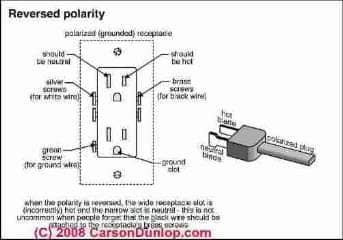
"Polarity" in an electrical receptacle and on the device that plugs into or connects to it means that we're making sure that we connect the "hot" or "live" side of the electrical circuit to the connection point in the appliance or device that was intended to be "hot" or "live".
Carson Dunlop's sketches show why it's important to respect polarity when connecting an electrical receptacle, a lamp or any other appliance.
Never clip or file down the prongs on a grounded or polarized plug in order to force it to fit into an older electrical receptacle. The risk is that your plug will be installed with reversed polarity - connecting the "hot" side of the electrical circuit to the normally neutral-wired side of the appliance. We've found appliances (a coffee maker) that simply burned up when connected in this fashion.
Go to the heart of the problem: Test and upgrade your electrical circuit system.
Watch Out: Do not attempt to work on your electrical wiring, switches, or outlets unless you are properly trained and equipped to do so. Electrical components in a building can easily cause an electrical shock, burn, or even death.
Even when a hot line switch is off, one terminal on the switch is still connected to the power source. Before doing any work on the switch, the power source must be turned off by setting a circuit breaker to OFF or removing a fuse.
See SAFETY for ELECTRICAL INSPECTORS
and ELECTRICAL WIRING BOOKS & GUIDES
Elizabeth Sluder contributed to the original text of this article.
Watch out: for safety, also
review SAFETY HAZARDS & SAFE ELECTRICAL INSPECTION PROCEDURES for Inspectors examining Residential Electrical Systems
and LOCAL ELECTRICAL GROUNDING for safety procedures during inspection of the grounding system.
This website provides information about a variety of electrical hazards in buildings, with articles focused on the inspection, detection, and reporting of electrical hazards and on proper electrical repair methods for unsafe electrical conditions. Critique and content suggestions are invited.
Reader Comments, Questions & Answers About The Article Above
Below you will find questions and answers previously posted on this page at its page bottom reader comment box.
Reader Q&A - also see RECOMMENDED ARTICLES & FAQs
Question: heating cables vs grounds
On 2021-05-15 - by (mod) -
@Jose montalvo,
Thank you for the question. The color codes for electrical wiring in the 1940s wear the same as today. That is, by convention, Black - hot, white-neutral, red-hot, green-ground.
On 2021-05-15 by Jose montalvo
Electrical wiring color code for homes built in the 1940s
On 2017-11-15 - by (mod) - replacing galvanized pipe with PEX (polyethylene plastic) pipe creates electrical grounding issues
Sure, Bill.
Any metal sinks and fixtures are no longer electrically grounded - if you knock a toaster into a sink there could be a hazard.
Any local grounds that were made to the metal piping system are no longer functional. (You might want to look for these, such as someone grounding an old appliance to a water pipe.)
Typically you'd want to meet current code for where you live: that may require two grounding electrodes.
On 2017-11-15 by Bill Medina
My home was built in 1972 with plumbing made of galvanized steel pipe. I am having the galvanized pipe replaced with PEX (polyethylene plastic) pipe. Are there any electrical grounding issues that I should be aware of? The old galvanized pipe will be abandoned in place, but sections of pipe may be removed during the repipe process. I have verified that the electrical grounding conductor from the main service panel is connected to a ground rod and there are no sub-panels in the house.
On 2015-07-17 - by (mod) - neutral and ground buses are connected in the main electrical panel but not ever in sub panels
David:
Don't be offended (if possible) when I warn that this work can kill someone or burn the place down if something is done incorrectly: those are reasons to hire a licensed electrician even if your local building department permits you to do your own work. At a minimum you'll want the work inspected by an expert.
Typically the neutral and ground buses are connected in the main electrical panel but not ever in sub panels. In the set-up that you describe I'd consider the fuse panel the main panel.
That means your distribution panel neutral wire will run out to the main fuse panel not directly to ground. CHECK this detail with your local code inspector.
On 2015-07-12 by David
I have an ungrounded electrical system in a 1960's cabin. I would like to completely rewire everything and safely install earth grounds and water/gas pipe grounds. I would also like to replace the distribution panel with one that has a ground bus. Here is where I am confused:
The electrical from the power company enters a meter. From the meter it enters an outdoor service box with two 60 amp fuses (the main shut off). It then travels indoors to the primary distribution panel.
**When I replace the indoor distribution panel, should the neutral bus bar be bonded to the ground bus bar or not? AND is it in this distribution panel that I should connect my #6 bare copper wire.
or should that connection be made at the service box outside? Does it matter which one I run from? The existing service box outside is throwing me off--I am used to seeing a main panel that connects directly to the meter. Thanks in advance for your help.
(Jan 28, 2014) Crank said:
On these pipes I need to put a heat cable to prevent the water pipes from freezing . Can I heat the pipe to 48 degrees with out messing up my grounds.Reply:
Sorry I don't understand the question. Certainly the heating cable would not normally interfere whatsoever with the electrical conductivity of metal water piping that itself is grounded.
In fact there will be no electrical contact between pipes and heater cables - that would be a short circuit and should trip a breaker, blow a fuse, and damage the heating cable.
And the change in pipe temperature won't harm its conductivity.
But the question leaves me worried by the phrase "messing up my grounds" - I'm not sure what you are actually considering.
If there is any doubt whether or not the building electrical ground system is complete and proper it would make sense to ask a licensed electrician to review it.
See water meter bypass grounding connections at ELECTRICAL GROUNDING in OLDER HOMES
Question: grounding ungrounded circuits
26 Feb 2015 Bob said:
Hi,
I'm redoing my kitchen, including ALL electrical. I ran a subpanel and ran all the required circuits from there.
My house was built in 1930. Electrical has been upgraded from knob and tube to metal clad without ground wire.
the bathroom upstairs was wired into the kitchen circuit, so now that I'm done with the kitchen there is a 2-wire cable hanging out of the kitchen ceiling and no electrical to the bathroom.
How do I tie the old ungrounded 2-wire metal clad into the new up-to-code grounded system of the kichen? Do I have to tear out all the walls and upgrade the bathroom now?
Reply:
For un-grounded circuits you need to only install un-grounded receptacles; you don't have a grounding conductor to connect to the rest of the building's ground system.
The armored cable will be grounded to the main panel or sub panel, but that's not a ground path for the circuits themselves.
The safer (and more costly) alternative is to re-wire the circuits entirely or to add n approved a grounding conductor throughout the old 2-wire circuits, junction boxes, receptacles, switches, electrical outlets, fixtures, etc.
28 Feb 2015 Bob said:
So, just to clarify:
There are no outlets on the bathroom circuit.
only lights
So I can tie the metal clad cable from the ceiling into the new junction box in the kitchen even though it doesn't have a ground?
Reply:
Bob I'm nervous about this as I don't really know what circuits are going where; if you are permitted to do your own wiring where you live you will still want to follow code and most likely need a permit and inspections, right?
The ceiling armored cable - is powering what? Are you connecting an old circuit to a newer one to extend the old circuit or what? I ask because in some cases you don't want to extend (add stuff to) an existing older circuit; the risk is overloading it, apart from the grounding questions.
Keep in mind that if you're discussing wiring into a bathroom, those circuits need GFCI protection. A GFCI can protect against some electrical faults even if there is no ground but one can't test that it's working properly using the test buttons as those short to ground.
28 Feb 2015 Bob said
Thanks for the reply.
No need to be nervous: I redid the bathroom a few years ago, added recessed lights, 3 GFCI outlets, and exhaust fan. All up to code on their own circuits into the new 200 amp main panel in the basement.
The only thing that existed at the time was the armored cable, non grounded circuit that came up in bathroom floor and went to the light fixture over the sink. I didn't rewire that.
Basement has the main panel, 1st floor is kitchen, and directly above kitchen on 2nd floor is the bathroom.
I'm now redoing the kitchen. I tore out all the non-grounded armored cable in the kitchen. The entire kitchen was fed by 1 armored cable from the basement on ONE circuit breaker, with lights and outlets on that 1 circuit. The armored cable that goes upstairs to the bathroom light fixture ALSO branched off from that kitchen wiring.
I've put a sub-panel in the kitchen and all wiring is up to code including 2 separate 20amp GFCI outlet circuits for the counter top spaces, dedicated 20 amp circuit for the dishwasher. The kitchen now has 6 total circuits for lights, outlets, etc, all grounded w 12/2 and 14/2 NM romex.
The problem is that single ungrounded AC line hanging out of the ceiling that goes upstairs to the light fixture in the bathroom. Because it is no longer tied into the kitchen wiring, the light fixture is dead. How do I deal with it? can I tie it into the metal light fixture box in the kitchen, even though it doesn't have a ground, or do I have to tear my bathroom apart and run 14/2 romex grounded all the way to the main panel in the basement on it's own circuit breaker???
I am doing the work myself. A check with City Hall assured me that I can do the work and have it inspected afterward as I did when I upgraded my FUSE box (with a total of 4 fuses!!) to 200 amp main panel with 40 spaces for circuit breakers.
Reply:
I didn't see an a question in your last longer comment that could safely be answered with no knowledge of the building and it's wiring, and we don't want to reply with mere arm-waving.
In general terms, all of the circuits in a modern home AND circuits that you work on in an older home should meet current electrical codes, including the provision of a grounding conductor and proper ground bonding in the junction boxes and connections to receptacles and light fixtures.
Certainly some light fixtures don't include a ground connection but many do, as a small copper wire coming out of the fixture base.
Bathrooms are areas of extra shock risk for obvious reasons: wet, proximity to plumbing. That's why GFCIs are required on receptacles there - your bath has omitted receptacles. You might consider the location of the light fixture. For example if it's conceivable that someone could touch the fixture and a sink or tub or pipe or wet surface the risks are increased and you'd perhaps be encouraged to add GFCI even on the lighting circuit. And grounding.
The "Code" question for your renovation work, in final authority, is in the hands of the local electrical inspector whose word is law. So if your question meant to ask "am I allowed to do x" it'd make sense to ask ahead of time directly the fellows who might otherwise make you do the work over again.
Ultimately and subject to inspection, you will decide if you are going to wire to current codes (including electrical grounding) or if you'll do what "works" to give light and take the remaining risks.
...
Continue reading at ELECTRICAL GROUND DEFINITIONS or select a topic from the closely-related articles below, or see the complete ARTICLE INDEX.
Or see these
Recommended Articles
- ELECTRIC PANEL INSPECTION
- ELECTRICAL SERVICE ENTRY DAMAGE
- GROUND SYSTEM INSPECTION - home
- ELECTRICAL GROUND ERROR-CAUSED LEAKS
- GAS PIPING GROUND BOND
- GROUND SYSTEM REQUIREMENTS
- KNOB & TUBE WIRING
- LIGHTNING PROTECTION SYSTEMS
- LOST ELECTRICAL GROUND
- SAFETY for ELECTRICAL INSPECTORS - home
- SERVICE GROUNDING DEFECTS
Suggested citation for this web page
ELECTRICAL GROUNDING in OLDER HOMES at InspectApedia.com - online encyclopedia of building & environmental inspection, testing, diagnosis, repair, & problem prevention advice.
Or see this
INDEX to RELATED ARTICLES: ARTICLE INDEX to ELECTRICAL INSPECTION & TESTING
Or use the SEARCH BOX found below to Ask a Question or Search InspectApedia
Ask a Question or Search InspectApedia
Try the search box just below, or if you prefer, post a question or comment in the Comments box below and we will respond promptly.
Search the InspectApedia website
Note: appearance of your Comment below may be delayed: if your comment contains an image, photograph, web link, or text that looks to the software as if it might be a web link, your posting will appear after it has been approved by a moderator. Apologies for the delay.
Only one image can be added per comment but you can post as many comments, and therefore images, as you like.
You will not receive a notification when a response to your question has been posted.
Please bookmark this page to make it easy for you to check back for our response.
Our Comment Box is provided by Countable Web Productions countable.ca
Citations & References
In addition to any citations in the article above, a full list is available on request.
- Jim P. Simmons, Licensed Electrician, 360-705-4225 Mr. Electric, is a Licensed Master Electrician in Olympia, Washington. Contact Jim P. Simmons, Licensed Master Electrician, Mr. Electric, 1320 Dayton Street SE Olympia, WA 98501, Ph 360-705-4225, Fx 360-705-0130 mrelectricoly@msn.com
- Elizabeth Sluder, Montross, VA, the original author of an earlier version of this article, is a public school teacher who writes basic educational articles about a variety of building, construction, and other topics. Her husband, a licensed electrician, consults for her writing on electrical topics. Her articles appearing at the InspectAPedia TM Website have been extensively edited, illustrated, and provided with supplemental content added by the website author. These articles are © 2010 InspectAPedia copyright-protected, all rights reserved.
- Mark Cramer Inspection Services Mark Cramer, Tampa Florida, Mr. Cramer is a past president of ASHI, the American Society of Home Inspectors and is a Florida home inspector and home inspection educator. Mr. Cramer serves on the ASHI Home Inspection Standards. Contact Mark Cramer at: 727-595-4211 mark@BestTampaInspector.com
- John Cranor [Website: /www.house-whisperer.com ] is an ASHI member and a home inspector (The House Whisperer) is located in Glen Allen, VA 23060. He is also a contributor to InspectApedia.com in several technical areas such as plumbing and appliances (dryer vents). Contact Mr. Cranor at 804-873-8534 or by Email: johncranor@verizon.net
- "Electrical System Inspection Basics," Richard C. Wolcott, ASHI 8th Annual Education Conference, Boston 1985.
- "Simplified Electrical Wiring," Sears, Roebuck and Co., 15705 (F5428) Rev. 4-77 1977 [Lots of sketches of older-type service panels.]
- "How to plan and install electric wiring for homes, farms, garages, shops," Montgomery Ward Co., 83-850.
- "Simplified Electrical Wiring," Sears, Roebuck and Co., 15705 (F5428) Rev. 4-77 1977 [Lots of sketches of older-type service panels.]
- "Home Wiring Inspection," Roswell W. Ard, Rodale's New Shelter, July/August, 1985 p. 35-40.
- "Evaluating Wiring in Older Minnesota Homes," Agricultural Extension Service, University of Minnesota, St. Paul, Minnesota 55108.
- In addition to citations & references found in this article, see the research citations given at the end of the related articles found at our suggested
CONTINUE READING or RECOMMENDED ARTICLES.
Search the InspectApedia website
Note: appearance of your Comment below may be delayed: if your comment contains an image, photograph, web link, or text that looks to the software as if it might be a web link, your posting will appear after it has been approved by a moderator. Apologies for the delay.
Only one image can be added per comment but you can post as many comments, and therefore images, as you like.
You will not receive a notification when a response to your question has been posted.
Please bookmark this page to make it easy for you to check back for our response.
Our Comment Box is provided by Countable Web Productions countable.ca
- Carson, Dunlop & Associates Ltd., 120 Carlton Street Suite 407, Toronto ON M5A 4K2. Tel: (416) 964-9415 1-800-268-7070 Email: info@carsondunlop.com. Alan Carson is a past president of ASHI, the American Society of Home Inspectors.
Thanks to Alan Carson and Bob Dunlop, for permission for InspectAPedia to use text excerpts from The HOME REFERENCE BOOK - the Encyclopedia of Homes and to use illustrations from The ILLUSTRATED HOME .
Carson Dunlop Associates provides extensive home inspection education and report writing material. In gratitude we provide links to tsome Carson Dunlop Associates products and services.


